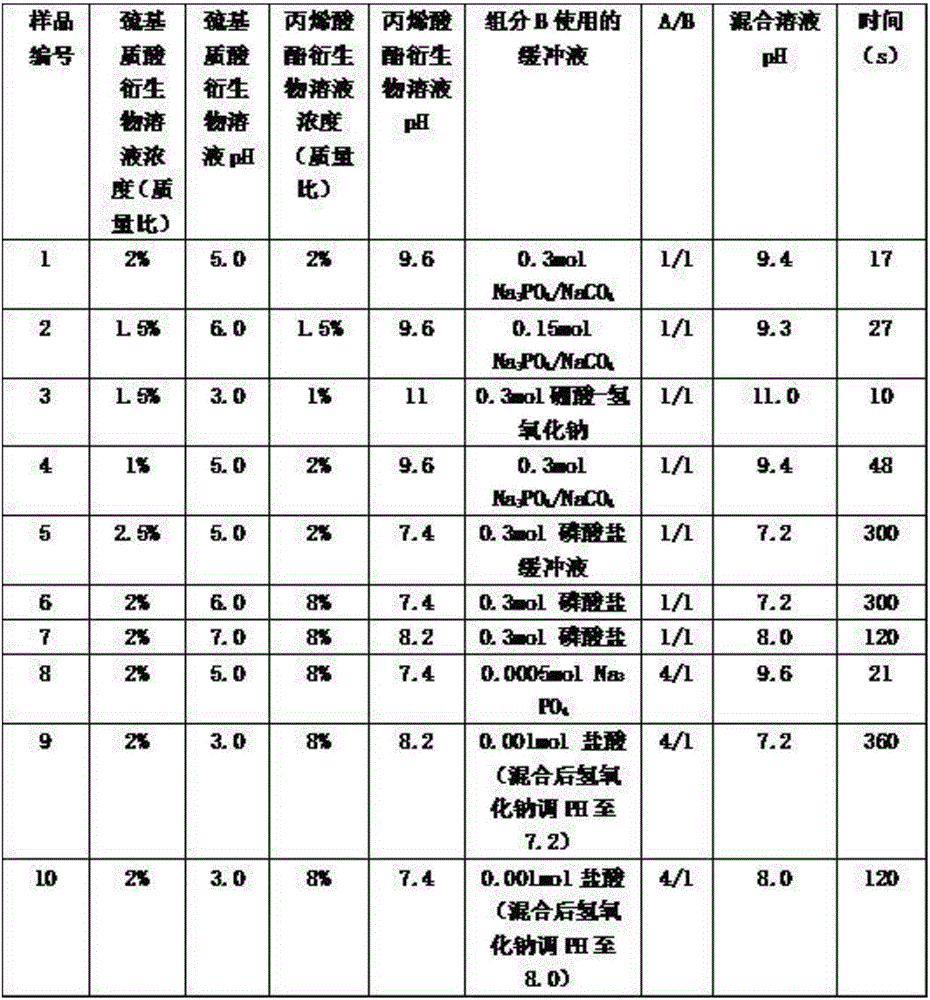Method for preparing liquid bandage for war wounds
A technology for liquid bandages and trauma, applied in bandages, medical science, etc., can solve the problems of not being able to meet the requirements of first aid for trauma, and achieve the effects of good stability, good biocompatibility, and low cost
- Summary
- Abstract
- Description
- Claims
- Application Information
AI Technical Summary
Problems solved by technology
Method used
Image
Examples
Embodiment 1
[0024] Preparation of thiol-containing acid derivative H-1:
[0025] Dissolve 10 grams of hyaluronic acid in 1 L of distilled water. Then add 12 grams of dithiodimalonyl hydrazide, fully stir to dissolve. Adjust the pH value of the above solution to 4.75 with 0.1mol / L dilute hydrochloric acid, then add 19.2 grams of 1-ethyl-3-(3-dimethylaminopropyl)carbodiimide hydrochloride, and continue stirring to fully dissolve it . React for 12 hours, and keep the pH value of the reaction solution at 4.75.
[0026] Use 1.0mol / L sodium hydroxide solution to adjust the pH of the solution in 1 to 7.0, then add 50 grams of dithiothreitol, and adjust the pH of the solution to 8.5. After reacting at room temperature for 24 hours, the pH of the solution was adjusted to 3.5 with 1 mol / L hydrochloric acid. Then put the sample into a dialysis bag for dialysis (molecular weight cut-off 3500), use pure water for dialysis for 4-5 days, and change the dialysis solution every 8 hours. Finally, the ...
Embodiment 2
[0028] Preparation of polyethylene glycol derivative PEG-2 containing dimethacrylic acid:
[0029] Add 4g of polyethylene glycol to 50mL of dichloromethane, then add 1g of triethylamine, and cool the mixture to 0°C. Then, a dichloromethane solution of 1 g of methacryloyl chloride was added dropwise into the reaction system, and the reaction was continuously stirred for 12 hours. The final product was finally obtained by three times of dichloromethane dissolution and ether precipitation purification.
Embodiment 3
[0031] Preparation of polyethylene glycol derivative PEG-4 containing tetramethacrylic acid:
[0032] Add 4g of polyethylene glycol to 50mL of dichloromethane, then add 1g of triethylamine, and cool the mixture to 0°C. Then, a dichloromethane solution of 1 g of methacryloyl chloride was added dropwise into the reaction system, and the reaction was continuously stirred for 12 hours. Then put the sample into a dialysis bag for dialysis (molecular weight cut-off 3500), use pure water for dialysis for 4 days, and change the dialysis solution every 8 hours. Finally, the solution in the dialysis tube was collected and freeze-dried to obtain a white flocculent solid.
PUM
 Login to View More
Login to View More Abstract
Description
Claims
Application Information
 Login to View More
Login to View More - R&D
- Intellectual Property
- Life Sciences
- Materials
- Tech Scout
- Unparalleled Data Quality
- Higher Quality Content
- 60% Fewer Hallucinations
Browse by: Latest US Patents, China's latest patents, Technical Efficacy Thesaurus, Application Domain, Technology Topic, Popular Technical Reports.
© 2025 PatSnap. All rights reserved.Legal|Privacy policy|Modern Slavery Act Transparency Statement|Sitemap|About US| Contact US: help@patsnap.com



